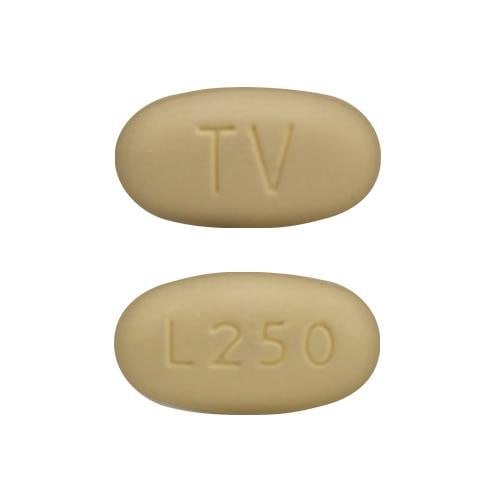Boxed Warning
Hepatotoxicity:
Hepatotoxicity has been observed in clinical trials and postmarketing experience. The hepatotoxicity may be severe, and deaths have been reported. Causality of the deaths is uncertain.
Dosage Forms
Excipient information presented when available (limited, particularly for generics); consult specific product labeling.
Tablet, Oral:
Tykerb: 250 mg [contains fd&c yellow #6 (sunset yellow), fd&c yellow #6 aluminum lake]
Pharmacology
Mechanism of Action
Tyrosine kinase (dual kinase) inhibitor; inhibits EGFR (ErbB1) and HER2 (ErbB2) by reversibly binding to tyrosine kinase, blocking phosphorylation and activation of downstream second messengers (Erk1/2 and Akt), regulating cellular proliferation and survival in ErbB- and ErbB2-expressing tumors. Combination therapy with lapatinib and endocrine therapy may overcome endocrine resistance occurring in HER2+ and hormone receptor positive disease.
Pharmacokinetics/Pharmacodynamics
Absorption
Incomplete and variable
Metabolism
Hepatic; extensive via CYP3A4 and 3A5, and to a lesser extent via CYP2C19 and 2C8 to oxidized metabolites
Excretion
Feces (27% as unchanged drug; range 3% to 67%); urine (<2%)
Time to Peak
~4 hours (Burris 2009)
Half-Life Elimination
~24 hours
Protein Binding
>99% to albumin and alpha1-acid glycoprotein
Use in Specific Populations
Special Populations: Hepatic Function Impairment
AUC increased (after a single 100 mg oral dose) by ~14% and 63% in patients with moderate (Child-Pugh class B) and severe (Child-Pugh class C) hepatic impairment, respectively.
Use: Labeled Indications
Breast cancer: Treatment of human epidermal growth receptor type 2 (HER2) overexpressing advanced or metastatic breast cancer (in combination with capecitabine) in patients who have received prior therapy (with an anthracycline, a taxane, and trastuzumab); HER2 overexpressing hormone receptor–positive metastatic breast cancer in postmenopausal women where hormone therapy is indicated (in combination with letrozole)
Limitations of use: Patients should have disease progression on trastuzumab prior to initiation of treatment with lapatinib in combination with capecitabine.
Use: Off Label
HER2 overexpressing metastatic breast cancer (in combination with trastuzumab) with progression on prior trastuzumab-containing therapyayes
Data from a phase III randomized controlled study supports the use of lapatinib in combination with trastuzumab in the management of metastatic breast cancer which has progressed on prior trastuzumab therapy Blackwell 2012.
Based on the American Society of Clinical Oncology (ASCO) guidelines for systemic therapy for advanced HER2-positive breast cancer, lapatinib in combination with trastuzumab is a third-line treatment option in patients whose disease has progressed during or after second line or greater HER2-targeted therapy.
HER2 overexpressing metastatic breast cancer with brain metastases (in combination with capecitabine)byes
Data from a small phase II study supports the use of lapatinib in combination with capecitabine in the management of HER2-positive metastatic breast cancer with brain metastases Bachelot 2013. Additional trials may be necessary to further define the role of lapatinib in the treatment of this condition.
The American Society of Clinical Oncology (ASCO) guidelines for disease management in patients with advanced HER2-positive breast cancer and brain metastases suggest lapatinib plus capecitabine as a systemic treatment option.
Contraindications
Known severe hypersensitivity to lapatinib or any component of the formulation
Dosage and Administration
Dosing: Adult
Breast cancer, metastatic, HER2+ (with prior anthracycline, taxane, and trastuzumab therapy): Oral: 1,250 mg once daily (in combination with capecitabine) until disease progression or unacceptable toxicity (Geyer 2006)
Breast cancer, metastatic, HER2+, hormonal therapy indicated: Oral: 1,500 mg once daily (in combination with letrozole) until disease progression (Johnston 2009)
Breast cancer, metastatic, HER2+ with brain metastases, first-line therapy (off-label use): Oral: 1,250 mg once daily (in combination with capecitabine) until disease progression or unacceptable toxicity (Bachelot 2013)
Breast cancer, metastatic, HER2+, with progression on prior trastuzumab therapy (off-label use): Oral: 1,000 mg once daily (in combination with trastuzumab) (Blackwell 2010; Blackwell 2012)
Missed doses: If a dose is missed, resume with the next scheduled daily dose; do not double the dose the next day.
Dosage adjustment for concomitant CYP3A4 inhibitors/inducers:
CYP3A4 inhibitors: Avoid the use of concomitant strong CYP3A4 inhibitors. If concomitant use cannot be avoided, consider reducing lapatinib to 500 mg once daily with careful monitoring. When a strong CYP3A4 inhibitor is discontinued, allow ~1 week to elapse prior to adjusting the lapatinib dose upward.
CYP3A4 inducers: Avoid the use of concomitant strong CYP3A4 inducers. If concomitant use cannot be avoided, consider gradually titrating lapatinib from 1,250 mg once daily up to 4,500 mg daily (in combination with capecitabine) or from 1,500 mg once daily up to 5,500 mg daily (in combination with letrozole), based on tolerability and with careful monitoring. If the strong CYP3A4 enzyme inducer is discontinued, reduce the lapatinib dose to the indicated dose.
Dosing: Geriatric
Refer to adult dosing.
Dosing: Adjustment for Toxicity
Cardiac toxicity: Discontinue treatment for at least 2 weeks for LVEF < LLN or decreased LVEF ≥ grade 2; may be restarted at 1,000 mg once daily (in combination with capecitabine) or 1,250 mg once daily (in combination with letrozole) if LVEF recovers to normal and patient is asymptomatic.
Dermatologic toxicity: Discontinue treatment for suspected erythema multiforme, Stevens-Johnson syndrome, or toxic epidermal necrolysis.
Diarrhea:
Grade 3 diarrhea or grade 1 or 2 diarrhea with complicating features (moderate-to-severe abdominal cramping, grade 2 or higher nausea/vomiting, decreased performance status, fever, sepsis, neutropenia, frank bleeding, or dehydration): Interrupt treatment; may restart at a reduced dose (from 1,500 mg once daily to 1,250 mg once daily or from 1,250 mg once daily to 1,000 mg once daily) when diarrhea resolves to ≤ grade 1.
Grade 4 diarrhea: Permanently discontinue.
Pulmonary toxicity: Discontinue treatment with pulmonary symptoms indicative of interstitial lung disease or pneumonitis which are ≥ grade 3
Other toxicities: Withhold for any toxicity (other than cardiac) ≥ grade 2 until toxicity resolves to ≤ grade 1 and reinitiate at the standard dose of 1,250 or 1,500 mg once daily; for persistent toxicity, reduce dosage to 1,000 mg once daily (in combination with capecitabine) or 1,250 mg once daily (in combination with letrozole)
Extemporaneously Prepared
A 50 mg/mL oral suspension may be prepared using lapatinib 250 mg tablets and Ora-Plus:Ora-Sweet (1:1 vehicle). Determine necessary quantity of lapatinib 250 mg tablets; crush the tablets in a glass mortar and triturate to a fine powder (estimated powder volume for each lapatinib 250 mg tablet is 0.6 mL). Measure the necessary volume of Ora-Plus and add to the powder by geometric dilution until a smooth suspension is created. Measure the necessary volume of Ora-Sweet and add to the suspension. Transfer to an amber plastic bottle and label “Shake Well Before Use”, “Do Not Refrigerate” and “Use by (date)”. Suspension is stable for at least 28 days at room temperature; do not refrigerate due to potential for increased viscosity.
Li Q, Liu Z, Kolli S, et al. Stability of extemporaneous erlotinib, lapatinib, and imatinib oral suspension. Am J Health Syst Pharm. 2016;73(17):1331-1337.27543577
Administration
Administer once daily, on an empty stomach, 1 hour before or 1 hour after a meal. Take full dose at the same time each day; dividing dose throughout the day is not recommended.
Note: For combination treatment with capecitabine, capecitabine should be administered in 2 doses (approximately 12 hours apart) and taken with food or within 30 minutes after a meal.
Dietary Considerations
Avoid grapefruit juice.
Storage
Store at room temperature of 25°C (77°F); excursions permitted between 15°C to 30°C (59°F to 86°F).
An oral suspension (50 mg/mL) prepared using lapatinib 250 mg tablets and Ora-Plus:Ora-Sweet (1:1 vehicle) is stable for at least 28 days at room temperature; do not refrigerate due to potential increased viscosity (Li 2016).
Lapatinib Images
Drug Interactions
Afatinib: P-glycoprotein/ABCB1 Inhibitors may increase the serum concentration of Afatinib. Management: Reduce afatinib by 10 mg if not tolerated. Some non-US labeling recommends avoiding combination if possible. If used, administer the P-gp inhibitor simultaneously with or after the dose of afatinib. Consider therapy modification
Alpelisib: BCRP/ABCG2 Inhibitors may increase the serum concentration of Alpelisib. Management: Avoid coadministration of BCRP/ABCG2 inhibitors and alpelisib due to the potential for increased alpelisib concentrations and toxicities. If coadministration cannot be avoided, closely monitor for increased alpelisib adverse reactions. Consider therapy modification
Aprepitant: May increase the serum concentration of CYP3A4 Substrates (High risk with Inhibitors). Monitor therapy
ARIPiprazole: CYP3A4 Inhibitors (Weak) may increase the serum concentration of ARIPiprazole. Management: Monitor for increased aripiprazole pharmacologic effects. Aripiprazole dose adjustments may or may not be required based on concomitant therapy and/or indication. Consult full interaction monograph for specific recommendations. Monitor therapy
Betrixaban: P-glycoprotein/ABCB1 Inhibitors may increase the serum concentration of Betrixaban. Management: Decrease the adult betrixaban dose to an initial single dose of 80 mg followed by 40 mg once daily if combined with a P-glycoprotein inhibitor. Consider therapy modification
Bilastine: P-glycoprotein/ABCB1 Inhibitors may increase the serum concentration of Bilastine. Management: Consider alternatives when possible; bilastine should be avoided in patients with moderate to severe renal insufficiency who are receiving p-glycoprotein inhibitors. Consider therapy modification
Bosentan: May decrease the serum concentration of CYP3A4 Substrates (High risk with Inducers). Monitor therapy
Brentuximab Vedotin: P-glycoprotein/ABCB1 Inhibitors may increase the serum concentration of Brentuximab Vedotin. Specifically, concentrations of the active monomethyl auristatin E (MMAE) component may be increased. Monitor therapy
Celiprolol: P-glycoprotein/ABCB1 Inhibitors may increase the serum concentration of Celiprolol. Monitor therapy
Cladribine: BCRP/ABCG2 Inhibitors may increase the serum concentration of Cladribine. Management: Avoid concomitant use of BCRP inhibitors during the 4 to 5 day oral cladribine treatment cycles whenever possible. If combined, consider dose reduction of the BCRP inhibitor and separation in the timing of administration. Consider therapy modification
Clofazimine: May increase the serum concentration of CYP3A4 Substrates (High risk with Inhibitors). Monitor therapy
Colchicine: P-glycoprotein/ABCB1 Inhibitors may increase the serum concentration of Colchicine. Colchicine distribution into certain tissues (e.g., brain) may also be increased. Management: Colchicine is contraindicated in patients with impaired renal or hepatic function who are also receiving a p-glycoprotein inhibitor. In those with normal renal and hepatic function, reduce colchicine dose as directed. See full monograph for details. Consider therapy modification
Conivaptan: May increase the serum concentration of CYP3A4 Substrates (High risk with Inhibitors). Avoid combination
CYP3A4 Inducers (Moderate): May decrease the serum concentration of CYP3A4 Substrates (High risk with Inducers). Monitor therapy
CYP3A4 Inducers (Strong): May decrease the serum concentration of Lapatinib. Management: If therapy overlap cannot be avoided, consider titrating lapatinib gradually from 1,250 mg/day up to 4,500 mg/day (HER2 positive metastatic breast cancer) or 1,500 mg/day up to 5,500 mg/day (hormone receptor/HER2 positive breast cancer) as tolerated. Avoid combination
CYP3A4 Inhibitors (Moderate): May decrease the metabolism of CYP3A4 Substrates (High risk with Inhibitors). Monitor therapy
CYP3A4 Inhibitors (Strong): May increase the serum concentration of Lapatinib. Management: If an overlap in therapy cannot be avoided, consider reducing lapatinib adult dose to 500 mg/day during, and within 1 week of completing, treatment with the strong CYP3A4 inhibitor. Avoid combination
Dabigatran Etexilate: P-glycoprotein/ABCB1 Inhibitors may increase serum concentrations of the active metabolite(s) of Dabigatran Etexilate. Monitor therapy
Dabrafenib: May decrease the serum concentration of CYP3A4 Substrates (High risk with Inducers). Management: Seek alternatives to the CYP3A4 substrate when possible. If concomitant therapy cannot be avoided, monitor clinical effects of the substrate closely (particularly therapeutic effects). Consider therapy modification
Deferasirox: May decrease the serum concentration of CYP3A4 Substrates (High risk with Inducers). Monitor therapy
DexAMETHasone (Systemic): May decrease the serum concentration of Lapatinib. Management: If therapy overlap cannot be avoided, consider titrating lapatinib gradually from 1,250 mg/day up to 4,500 mg/day (HER2 positive metastatic breast cancer) or 1,500 mg/day up to 5,500 mg/day (hormone receptor/HER2 positive breast cancer) as tolerated. Avoid combination
Dofetilide: CYP3A4 Inhibitors (Weak) may increase the serum concentration of Dofetilide. Monitor therapy
DOXOrubicin (Conventional): P-glycoprotein/ABCB1 Inhibitors may increase the serum concentration of DOXOrubicin (Conventional). Management: Seek alternatives to P-glycoprotein inhibitors in patients treated with doxorubicin whenever possible. One U.S. manufacturer (Pfizer Inc.) recommends that these combinations be avoided. Consider therapy modification
Duvelisib: May increase the serum concentration of CYP3A4 Substrates (High risk with Inhibitors). Monitor therapy
Edoxaban: P-glycoprotein/ABCB1 Inhibitors may increase the serum concentration of Edoxaban. Management: See full monograph for details. Reduced doses are recommended for patients receiving edoxaban for venous thromboembolism in combination with certain P-gp inhibitors. Similar dose adjustment is not recommended for edoxaban use in atrial fibrillation. Consider therapy modification
Erdafitinib: May decrease the serum concentration of CYP3A4 Substrates (High risk with Inducers). Monitor therapy
Erdafitinib: May increase the serum concentration of CYP3A4 Substrates (High risk with Inhibitors). Monitor therapy
Erdafitinib: May increase the serum concentration of P-glycoprotein/ABCB1 Substrates. Monitor therapy
Everolimus: P-glycoprotein/ABCB1 Inhibitors may increase the serum concentration of Everolimus. Monitor therapy
Flibanserin: CYP3A4 Inhibitors (Weak) may increase the serum concentration of Flibanserin. Monitor therapy
Fosaprepitant: May increase the serum concentration of CYP3A4 Substrates (High risk with Inhibitors). Monitor therapy
Fosnetupitant: May increase the serum concentration of CYP3A4 Substrates (High risk with Inhibitors). Monitor therapy
Fusidic Acid (Systemic): May increase the serum concentration of CYP3A4 Substrates (High risk with Inhibitors). Avoid combination
Grapefruit Juice: May increase the serum concentration of Lapatinib. Avoid combination
Haloperidol: QT-prolonging Agents (Indeterminate Risk - Caution) may enhance the QTc-prolonging effect of Haloperidol. Monitor therapy
Idelalisib: May increase the serum concentration of CYP3A4 Substrates (High risk with Inhibitors). Avoid combination
Ivosidenib: May decrease the serum concentration of CYP3A4 Substrates (High risk with Inducers). Monitor therapy
Larotrectinib: May increase the serum concentration of CYP3A4 Substrates (High risk with Inhibitors). Monitor therapy
Larotrectinib: P-glycoprotein/ABCB1 Inhibitors may increase the serum concentration of Larotrectinib. Monitor therapy
Lasmiditan: May increase the serum concentration of P-glycoprotein/ABCB1 Substrates. Avoid combination
Lefamulin: P-glycoprotein/ABCB1 Inhibitors may increase the serum concentration of Lefamulin. Management: Avoid concomitant use of lefamulin tablets with P-glycoprotein/ABCB1 inhibitors. If concomitant use is required, monitor for lefamulin adverse effects. Consider therapy modification
Lemborexant: CYP3A4 Inhibitors (Weak) may increase the serum concentration of Lemborexant. Management: The maximum recommended dosage of lemborexant is 5 mg, no more than once per night, when coadministered with weak CYP3A4 inhibitors. Consider therapy modification
Lomitapide: CYP3A4 Inhibitors (Weak) may increase the serum concentration of Lomitapide. Management: Patients on lomitapide 5 mg/day may continue that dose. Patients taking lomitapide 10 mg/day or more should decrease the lomitapide dose by half. The lomitapide dose may then be titrated up to a max adult dose of 30 mg/day. Consider therapy modification
Lorlatinib: May decrease the serum concentration of CYP3A4 Substrates (High risk with Inducers). Management: Avoid concurrent use of lorlatinib with any CYP3A4 substrates for which a minimal decrease in serum concentrations of the CYP3A4 substrate could lead to therapeutic failure and serious clinical consequences. Consider therapy modification
Naldemedine: P-glycoprotein/ABCB1 Inhibitors may increase the serum concentration of Naldemedine. Monitor therapy
Naloxegol: P-glycoprotein/ABCB1 Inhibitors may increase the serum concentration of Naloxegol. Monitor therapy
Netupitant: May increase the serum concentration of CYP3A4 Substrates (High risk with Inhibitors). Monitor therapy
NiMODipine: CYP3A4 Inhibitors (Weak) may increase the serum concentration of NiMODipine. Monitor therapy
Palbociclib: May increase the serum concentration of CYP3A4 Substrates (High risk with Inhibitors). Monitor therapy
PAZOPanib: Lapatinib may enhance the QTc-prolonging effect of PAZOPanib. Lapatinib may increase the serum concentration of PAZOPanib. Avoid combination
P-glycoprotein/ABCB1 Inhibitors: May increase the serum concentration of P-glycoprotein/ABCB1 Substrates. P-glycoprotein inhibitors may also enhance the distribution of p-glycoprotein substrates to specific cells/tissues/organs where p-glycoprotein is present in large amounts (e.g., brain, T-lymphocytes, testes, etc.). Monitor therapy
P-glycoprotein/ABCB1 Substrates: P-glycoprotein/ABCB1 Inhibitors may increase the serum concentration of P-glycoprotein/ABCB1 Substrates. P-glycoprotein inhibitors may also enhance the distribution of p-glycoprotein substrates to specific cells/tissues/organs where p-glycoprotein is present in large amounts (e.g., brain, T-lymphocytes, testes, etc.). Exceptions: Loperamide. Monitor therapy
Pimozide: CYP3A4 Inhibitors (Weak) may increase the serum concentration of Pimozide. Avoid combination
Prucalopride: P-glycoprotein/ABCB1 Inhibitors may increase the serum concentration of Prucalopride. Monitor therapy
QT-prolonging Agents (Highest Risk): QT-prolonging Agents (Indeterminate Risk - Caution) may enhance the QTc-prolonging effect of QT-prolonging Agents (Highest Risk). Management: Monitor for QTc interval prolongation and ventricular arrhythmias when these agents are combined. Patients with additional risk factors for QTc prolongation may be at even higher risk. Monitor therapy
Ranolazine: P-glycoprotein/ABCB1 Inhibitors may increase the serum concentration of Ranolazine. Monitor therapy
Ranolazine: May increase the serum concentration of P-glycoprotein/ABCB1 Substrates. Monitor therapy
RifAXIMin: P-glycoprotein/ABCB1 Inhibitors may increase the serum concentration of RifAXIMin. Monitor therapy
Sarilumab: May decrease the serum concentration of CYP3A4 Substrates (High risk with Inducers). Monitor therapy
Silodosin: P-glycoprotein/ABCB1 Inhibitors may increase the serum concentration of Silodosin. Monitor therapy
Siltuximab: May decrease the serum concentration of CYP3A4 Substrates (High risk with Inducers). Monitor therapy
Simeprevir: May increase the serum concentration of CYP3A4 Substrates (High risk with Inhibitors). Monitor therapy
St John's Wort: May decrease the serum concentration of Lapatinib. Management: If therapy overlap cannot be avoided, consider titrating lapatinib gradually from 1,250 mg/day up to 4,500 mg/day (HER2 positive metastatic breast cancer) or 1,500 mg/day up to 5,500 mg/day (hormone receptor/HER2 positive breast cancer) as tolerated. Avoid combination
Stiripentol: May increase the serum concentration of CYP3A4 Substrates (High risk with Inhibitors). Management: Use of stiripentol with CYP3A4 substrates that are considered to have a narrow therapeutic index should be avoided due to the increased risk for adverse effects and toxicity. Any CYP3A4 substrate used with stiripentol requires closer monitoring. Consider therapy modification
Talazoparib: P-glycoprotein/ABCB1 Inhibitors may increase the serum concentration of Talazoparib. Management: These listed exceptions are discussed in detail in separate interaction monographs. Monitor therapy
Talazoparib: BCRP/ABCG2 Inhibitors may increase the serum concentration of Talazoparib. Monitor therapy
Tegaserod: P-glycoprotein/ABCB1 Inhibitors may increase the serum concentration of Tegaserod. Monitor therapy
Tocilizumab: May decrease the serum concentration of CYP3A4 Substrates (High risk with Inducers). Monitor therapy
Topotecan: BCRP/ABCG2 Inhibitors may increase the serum concentration of Topotecan. Avoid combination
Topotecan: P-glycoprotein/ABCB1 Inhibitors may increase the serum concentration of Topotecan. Avoid combination
Triazolam: CYP3A4 Inhibitors (Weak) may increase the serum concentration of Triazolam. Management: Consider triazolam dose reduction in patients receiving concomitant weak CYP3A4 inhibitors. Consider therapy modification
Ubrogepant: CYP3A4 Inhibitors (Weak) may increase the serum concentration of Ubrogepant. Management: In patients taking weak CYP3A4 inhibitors, the initial and second dose (if needed) of ubrogepant should be limited to 50 mg. Consider therapy modification
Venetoclax: P-glycoprotein/ABCB1 Inhibitors may increase the serum concentration of Venetoclax. Management: Consider a venetoclax dose reduction by at least 50% in patients requiring concomitant treatment with P-glycoprotein (P-gp) inhibitors. Consider therapy modification
VinCRIStine (Liposomal): P-glycoprotein/ABCB1 Inhibitors may increase the serum concentration of VinCRIStine (Liposomal). Avoid combination
Adverse Reactions
Percentages reported for combination therapy.
>10%:
Central nervous system: Fatigue (≤20%), headache (14%)
Dermatologic: Palmar-plantar erythrodysesthesia (with capecitabine: 53%), skin rash (28% to 44%), alopecia (13%), xeroderma (10% to 13%), pruritus (12%), nail disease (11%)
Gastrointestinal: Diarrhea (64% to 65%), nausea (31% to 44%), vomiting (17% to 26%), mucositis (15%), stomatitis (14%), anorexia (11%), dyspepsia (11%)
Hematologic & oncologic: Decreased hemoglobin (with capecitabine: 56%; grade 3: <1%), decreased neutrophils (with capecitabine: 22%; grade 3: 3%; grade 4: <1%), decreased platelet count (with capecitabine: 18%; grade 3: <1%)
Hepatic: Increased serum aspartate aminotransferase (49% to 53%), increased serum alanine aminotransferase (37% to 46%), increased serum bilirubin (22% to 45%)
Neuromuscular & skeletal: Asthenia (12%), limb pain (12%), back pain (11%)
Respiratory: Dyspnea (12%), epistaxis (11%)
1% to 10%:
Cardiovascular: Decreased left ventricular ejection fraction (with letrozole: 5%; with capecitabine: grade 2: 2%; grade 3: <1%)
Central nervous system: Insomnia (10%)
<1%, postmarketing, and/or case reports: Anaphylaxis, hepatotoxicity, hypersensitivity reaction, interstitial pulmonary disease, paronychia, pneumonitis, prolonged Q-T interval on ECG, severe dermatological reaction, Stevens-Johnson syndrome, torsades de pointes, toxic epidermal necrolysis, ventricular arrhythmia
Warnings/Precautions
Concerns related to adverse effects:
- Cardiotoxicity: Decreases in left ventricular ejection fraction (LVEF) have been reported (usually within the first 3 months of treatment); baseline and periodic LVEF evaluations are recommended. Interrupt treatment with decreased LVEF ≥ grade 2 or LVEF < LLN; may reinitiate with a reduced dose after a minimum of 2 weeks if the LVEF recovers and the patient is asymptomatic. Use with caution in conditions which may impair left ventricular function and in patients with a history of or predisposed to (prior treatment with anthracyclines, chest wall irradiation) left ventricular dysfunction. In a scientific statement from the American Heart Association, lapatinib has been determined to be an agent that may either cause reversible direct myocardial toxicity or exacerbate underlying myocardial dysfunction (magnitude: moderate/major) (AHA [Page 2016]).
- Dermatologic toxicity: Severe cutaneous reactions have been reported with use. Discontinue therapy if life-threatening dermatologic reactions (eg, progressive skin rash with blisters or mucosal lesions) such as erythema multiforme, Stevens-Johnson syndrome, or toxic epidermal necrolysis occur.
- Diarrhea: Diarrhea is common (onset is generally within 6 days and duration is 4 to 5 days); may be severe and/or fatal. Diarrhea is best managed with early intervention; instruct patients to immediately report any bowel pattern changes. After first unformed stool, administer antidiarrheal agents; severe diarrhea may require hydration, electrolytes, antibiotics (if duration >24 hours, fever, or grade 3/4 neutropenia), and/or treatment interruption, dose reduction, or discontinuation.
- Hepatotoxicity: [US Boxed Warning]: Hepatotoxicity (ALT or AST >3 times ULN and total bilirubin >2 times ULN) has been reported with lapatinib; may be severe and/or fatal. Onset may occur within days to several months after treatment initiation. Monitor transaminases, bilirubin, and alkaline phosphatase (at baseline and every 4 to 6 weeks during treatment, and as clinically indicated); discontinue with severe changes in liver function during treatment; do not reinitiate.
- Pulmonary toxicity: Interstitial lung disease (ILD) and pneumonitis have been reported (with lapatinib monotherapy and combination chemotherapy); monitor for pulmonary symptoms which may indicate ILD or pneumonitis; discontinue treatment for grade 3 (or higher) pulmonary symptoms indicative of ILD or pneumonitis (eg, dyspnea, dry cough).
- QTC prolongation: Concentration-dependent QTC prolongation has been observed; use caution in patients with a history of QTC prolongation or with medications known to prolong the QT interval; baseline and periodic 12-lead ECG should be considered; correct electrolyte (potassium, calcium, and magnesium) abnormalities prior to and during treatment. Concurrent use with other drugs which may prolong QTC interval may increase the risk of potentially fatal arrhythmias.
Disease related concerns:
- Hepatic impairment: Use with caution in patients with hepatic impairment; dose reductions should be considered in patients with preexisting severe (Child-Pugh class C) hepatic impairment.
Concurrent drug therapy issues:
- Drug-drug interactions: Potentially significant interactions may exist, requiring dose or frequency adjustment, additional monitoring, and/or selection of alternative therapy. Consult drug interactions database for more detailed information.
Special populations:
- Pharmacogenomics: Patients who carry the HLA alleles DQA1*02:01 and DRB1*07:01 may experience a greater incidence of severe liver injury than patients who are noncarriers. These alleles are present in ~15% to 25% of Caucasian, Asian, African, and Hispanic patient populations and 1% in Japanese populations.
Monitoring Parameters
LVEF (baseline and periodic), CBC with differential, liver function tests, including transaminases, bilirubin, and alkaline phosphatase (baseline and every 4-6 weeks during treatment); electrolytes including calcium, potassium, magnesium; monitor for fluid retention; ECG monitoring if at risk for QTc prolongation; symptoms of ILD or pneumonitis; monitor for diarrhea and dermatologic toxicity
Evaluate pregnancy status in females of reproductive potential prior to therapy.
Pregnancy
Pregnancy Considerations
Based on the mechanism of action and data from animal reproduction studies, in utero exposure to lapatinib may cause fetal harm. Pregnant females and females of reproductive potential should be advised of the potential risk to the fetus.
European Society for Medical Oncology (ESMO) guidelines for cancer during pregnancy recommend delaying treatment with HER-2 targeted agents until after delivery in pregnant patients with HER-2 positive disease (Peccatori 2013).
Pregnancy status should be determined prior to initiation of lapatinib. Females of reproductive potential and male patients with female partners of reproductive potential should be advised to use effective contraception during treatment and for 1 week after the last lapatinib dose.
Patient Education
What is this drug used for?
- It is used to treat breast cancer.
Frequently reported side effects of this drug
- Dry skin
- Itching
- Headache
- Hair loss
- Back pain
- Nosebleed
- Nail changes
- Mouth sores
- Mouth irritation
- Loss of strength and energy
- Lack of appetite
- Painful extremities
- Trouble sleeping
Other side effects of this drug: Talk with your doctor right away if you have any of these signs of:
- Liver problems like dark urine, fatigue, lack of appetite, nausea, abdominal pain, light-colored stools, vomiting, or yellow skin
- Severe pulmonary disorder like lung or breathing problems like difficulty breathing, shortness of breath, or a cough that is new or worse
- Shortness of breath
- Excessive weight gain
- Swelling of arms or legs
- Abnormal heartbeat
- Fast heartbeat
- Dizziness
- Passing out
- Severe abdominal pain
- Severe diarrhea
- Diarrhea with abdominal cramps
- Severe nausea
- Vomiting
- Fever
- Fluid loss
- Redness of irritation on palms or soles of feet
- Stevens-Johnson syndrome/toxic epidermal necrolysis like red, swollen, blistered, or peeling skin (with or without fever); red or irritated eyes; or sores in mouth, throat, nose, or eyes
- Signs of a significant reaction like wheezing; chest tightness; fever; itching; bad cough; blue skin color; seizures; or swelling of face, lips, tongue, or throat.
Note: This is not a comprehensive list of all side effects. Talk to your doctor if you have questions.
Consumer Information Use and Disclaimer: This information should not be used to decide whether or not to take this medicine or any other medicine. Only the healthcare provider has the knowledge and training to decide which medicines are right for a specific patient. This information does not endorse any medicine as safe, effective, or approved for treating any patient or health condition. This is only a brief summary of general information about this medicine. It does NOT include all information about the possible uses, directions, warnings, precautions, interactions, adverse effects, or risks that may apply to this medicine. This information is not specific medical advice and does not replace information you receive from the healthcare provider. You must talk with the healthcare provider for complete information about the risks and benefits of using this medicine.





